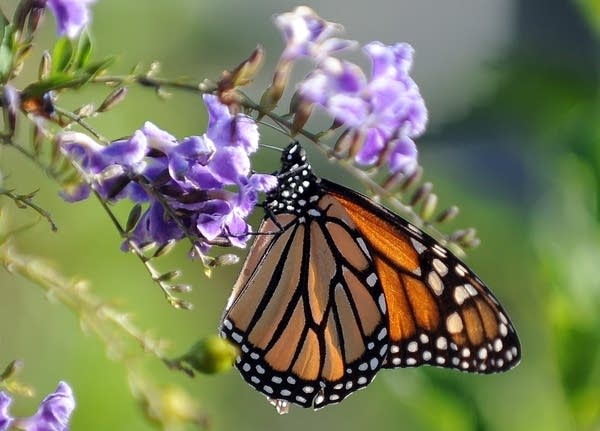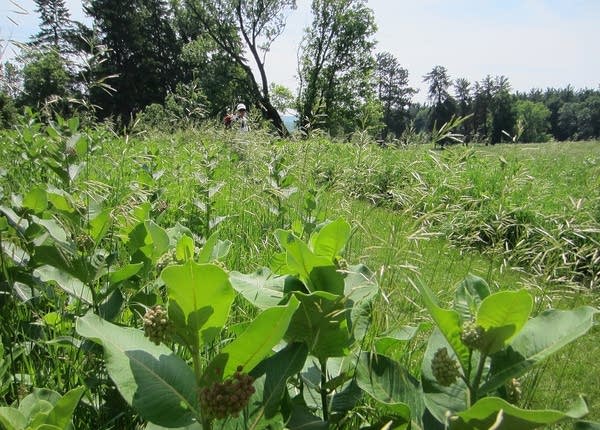Minn. sightings of monarch butterfly rare as population crashes

Go Deeper.
Create an account or log in to save stories.
Like this?
Thanks for liking this story! We have added it to a list of your favorite stories.
"I'm hoping we see a monarch today," Dave Kust says as he searches for the butterfly's familiar black and orange wings. "This is the longest I've had to wait to see a Monarch in years."
An avid butterfly observer and teacher, Kust explores his yard for monarch clues, checking beneath the leaves of milkweed, where the creatures lay their eggs.
The weather is perfect for a search. But the monarch, Minnesota's state butterfly and one of its most colorful summer residents, can't be found. The migrating population has crashed. Sightings are rare.
Scientists blame extreme weather in the southern states for a massive die-off of the Monarch this year. Its absence may also be sending messages about the environment's health.
Turn Up Your Support
MPR News helps you turn down the noise and build shared understanding. Turn up your support for this public resource and keep trusted journalism accessible to all.
Suburban sprawl, mowing and farm chemicals have reduced the population of milkweed, the only plant where monarchs place eggs.
A generation of monarchs may have been lost, says Elizabeth Howard, director and founder of the Monarch research group Journey North.

The cold blooded insects that survived and made it north begin leaving by about mid-August as they start their journey south to Mexico.
With a life span of only 30 days, the timing has to be right. Howard says Monarchs need a temperature of 55 degrees to flex their muscles and fly. "Their lives are governed by temperature ... in a normal year the monarchs arrive when the milkweeds arrive."
Researchers early this year noticed that instead of wintering in Mexico's sanctuaries on 17 acres of forest, the Monarchs were found on only three acres.
They estimate the Mexico winter population was 60 million, down from 350 million the year before. They attributed the mortality to last year's drought and heat in southern states.
Howard says this year for the monarchs' journey north there was an unusually cold spring in Texas, an important way station, and milkweed plants weren't far enough along to allow egg laying.

Even in the best conditions, it's a perilous, extraordinary trek.
Twice a year, monarchs weighing little more than an office paper clip brave weather, predators and disease as they travel more than three thousand miles.
Their migration takes them from sanctuaries in the mountains of Mexico as far north as Canada. On the way, the monarchs are on the lookout for the milkweed.
The monarchs' visit to Minnesota is short but eventful. The next generation is born here, and by mid-August the migration back to Mexico begins.
"The female will sit on the plant and it'll drop their abdomen underneath, and like a little piece of glue [the egg] sticks right on the underside of that," says Kust, one of nearly a million volunteers across North America who observe and chart the monarchs' remarkable migrations. "They're very small, almost like a pinhead and shaped like a football oval..."
Just over a decade ago Kust, an elementary school teacher who traces his love of the outdoors to childhood, visited the monarchs' winter sanctuaries in Mexico.
By chance he witnessed a colossal die off caused by a freak storm. Monarchs by the hundreds of millions, maybe up to 80 percent of the population, perished. Kust assisted scientists as they rushed to the scene to record the disaster.
These days, he takes an 'act locally' approach to help preserve the monarch population. He encourages landowners to create Monarch rest stops.
"Milkweed and nectoring plants in their backyards and front yards, and if we can keep insecticides out of ditches and mowing to a minimum, and whether you have a waterfall or birdbath or sprinkler in your yard, they do need water," Kust said.
The health of the milkweed plant population is key to monarch survival during their month-long life span. Kust sees himself as a Johnny Appleseed-like character as he spreads milkweed pods around his home and into the neighbor's yards.
"Anybody who likes gardening, it's pretty easy to encourage that," he said. "It's not a hard sell."
On this day, though, the milkweed hides "lots of ants and aphids" but no Monarch eggs. "Struck out again," says Kust.


